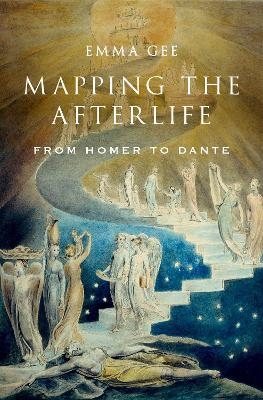
Mapping the Afterlife
From Homer to Dante
Seiten
2020
Oxford University Press Inc (Verlag)
978-0-19-067048-1 (ISBN)
Oxford University Press Inc (Verlag)
978-0-19-067048-1 (ISBN)
This book studies the afterlife from Homer to Dante. It posits that there is a dominant spatial idiom in afterlife landscapes, the 'Journey-Vision paradigm:' i.e. the journey through the underworld, and the Vision of the universe. This spatial duality functions to harmonise the underworld with the 'scientific' universe.
There are very few accounts of the afterlife across the period from Homer to Dante. Most traditional studies approach the classical afterlife from the point of view of its "evolution" towards the Christian afterlife. This book tries to do something different: to explore afterlife narratives in spatial terms and to situate this tradition within the ambit of a fundamental need in human psychology for the synthesis of soul (or "self") and universe.
Drawing on the works of Homer, Plato, Cicero, Virgil, and Dante, among others, as well as on modern works on psychology, cartography, and music theory, Mapping the Afterlife argues that the topography of the afterlife in the Greek and Roman tradition, and in Dante, reflects the state of "scientific" knowledge at the time of the various contexts in which we find it. The book posits that there is a dominant spatial idiom in afterlife landscapes, a "journey-vision paradigm"--the horizontal journey of the soul across the afterlife landscape, and a synoptic vision of the universe. Many scholars have argued that the vision of the universe is out of place in the underworld landscape. However, looking across the entire tradition, we find that afterlife landscapes, almost without exception, contain these two kinds of space in one form or another. This double vision of space brings the underworld, as the landscape of the soul, into contact with the "scientific" universe; and brings humanity into line with the cosmos.
There are very few accounts of the afterlife across the period from Homer to Dante. Most traditional studies approach the classical afterlife from the point of view of its "evolution" towards the Christian afterlife. This book tries to do something different: to explore afterlife narratives in spatial terms and to situate this tradition within the ambit of a fundamental need in human psychology for the synthesis of soul (or "self") and universe.
Drawing on the works of Homer, Plato, Cicero, Virgil, and Dante, among others, as well as on modern works on psychology, cartography, and music theory, Mapping the Afterlife argues that the topography of the afterlife in the Greek and Roman tradition, and in Dante, reflects the state of "scientific" knowledge at the time of the various contexts in which we find it. The book posits that there is a dominant spatial idiom in afterlife landscapes, a "journey-vision paradigm"--the horizontal journey of the soul across the afterlife landscape, and a synoptic vision of the universe. Many scholars have argued that the vision of the universe is out of place in the underworld landscape. However, looking across the entire tradition, we find that afterlife landscapes, almost without exception, contain these two kinds of space in one form or another. This double vision of space brings the underworld, as the landscape of the soul, into contact with the "scientific" universe; and brings humanity into line with the cosmos.
Emma Gee is an independent scholar and tutor in the Classics. Her previous books include Aratus and the Astronomical Tradition and Ovid, Aratus, and Augustus.
Introduction
PART 1: DUALITIES
Chapter 1: The Splitting of Herakles
Chapter 2: The Roadmap
Chapter 3: Proserpina's Tapestry, Strabo's Cloak
PART 2: COSMOS
Chapter 4: The Cloak of Stars
Chapter 5: Soul Music
Intermezzo
PART 3: PLATO'S SOULSCAPES
Chapter 6: Interplanetary Harmonies
Chapter 7: A Sprinkling of Science
Chapter 8: The Lyre and the Cloak
PART 4: TO THE SKY
Chapter 9: The Dark Side of the Moon
Chapter 10: Dante's Poem of Fire
Conclusion
Bibliography
Index
Endpiece
| Erscheinungsdatum | 23.04.2020 |
|---|---|
| Verlagsort | New York |
| Sprache | englisch |
| Maße | 236 x 155 mm |
| Gewicht | 635 g |
| Themenwelt | Geschichte ► Allgemeine Geschichte ► Altertum / Antike |
| Geisteswissenschaften ► Philosophie ► Philosophie Altertum / Antike | |
| Geisteswissenschaften ► Religion / Theologie ► Weitere Religionen | |
| Sozialwissenschaften ► Soziologie | |
| ISBN-10 | 0-19-067048-7 / 0190670487 |
| ISBN-13 | 978-0-19-067048-1 / 9780190670481 |
| Zustand | Neuware |
| Haben Sie eine Frage zum Produkt? |
Mehr entdecken
aus dem Bereich
aus dem Bereich
Die unglaubliche Geschichte eines antiken Söldnerheeres
Buch | Hardcover (2022)
C.H.Beck (Verlag)
CHF 39,20
die Inszenierung der Politik in der römischen Republik
Buch | Hardcover (2023)
C.H.Beck (Verlag)
CHF 67,20


